英语四级必备知识点
- 格式:pdf
- 大小:1.72 MB
- 文档页数:13
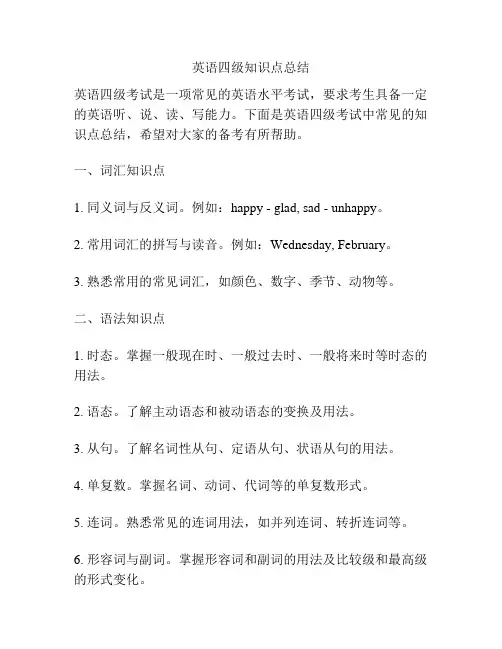
英语四级知识点总结英语四级考试是一项常见的英语水平考试,要求考生具备一定的英语听、说、读、写能力。
下面是英语四级考试中常见的知识点总结,希望对大家的备考有所帮助。
一、词汇知识点1. 同义词与反义词。
例如:happy - glad, sad - unhappy。
2. 常用词汇的拼写与读音。
例如:Wednesday, February。
3. 熟悉常用的常见词汇,如颜色、数字、季节、动物等。
二、语法知识点1. 时态。
掌握一般现在时、一般过去时、一般将来时等时态的用法。
2. 语态。
了解主动语态和被动语态的变换及用法。
3. 从句。
了解名词性从句、定语从句、状语从句的用法。
4. 单复数。
掌握名词、动词、代词等的单复数形式。
5. 连词。
熟悉常见的连词用法,如并列连词、转折连词等。
6. 形容词与副词。
掌握形容词和副词的用法及比较级和最高级的形式变化。
三、阅读理解1. 掌握阅读理解的技巧,如扫读、略读、精读等。
2. 理解文章的大意和细节信息。
3. 掌握寻找关键词和主题句的方法。
4. 注意推理和推断,特别是根据上下文推断词义。
四、写作技巧1. 掌握写作的基本句型和表达方式。
2. 增加词汇量,提高句子的表达能力。
3. 练习写作各类题型,如图表作文、观点对比、描述事件等。
4. 注意时态、语态和语法的正确使用。
五、听力技巧1. 提高听力理解能力。
2. 注意听清关键信息,如数字、时间、地点等。
3. 练习听懂不同口音和语速的英语。
六、口语表达1. 增加口语词汇量,提高口语表达能力。
2. 练习口语的听说能力,如对话、问答等。
3. 注意语音、语调和语速的正确运用。
以上是英语四级考试常见的知识点总结,希望能够对大家的备考有所帮助。
另外,备考过程中要多进行模拟测试,提高应试能力,同时也要注意积累语言实际运用能力,灵活应对各种题型和情境。
最重要的是多进行实践,多进行口头和书面的练习,提高语言的应用能力。
祝愿大家取得好成绩!。
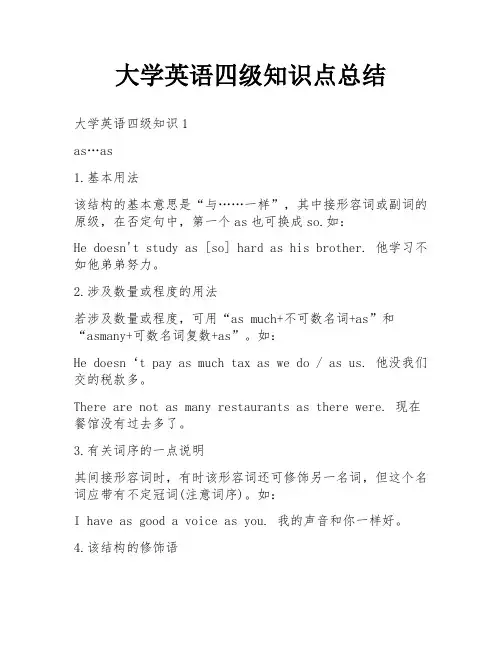
大学英语四级知识点总结大学英语四级知识1as…as1.基本用法该结构的基本意思是“与……一样”,其中接形容词或副词的原级,在否定句中,第一个as也可换成so.如:He doesn't study as [so] hard as his brother. 他学习不如他弟弟努力。
2.涉及数量或程度的用法若涉及数量或程度,可用“as much+不可数名词+as”和“asmany+可数名词复数+as”。
如:He doesn‘t pay as much tax as we do / as us. 他没我们交的税款多。
There are not as many restaurants as there were. 现在餐馆没有过去多了。
3.有关词序的一点说明其间接形容词时,有时该形容词还可修饰另一名词,但这个名词应带有不定冠词(注意词序)。
如:I have as good a voice as you. 我的声音和你一样好。
4.该结构的修饰语根据情况可用(not) nearly, almost, just, nothing like, exactly, not quite, half, one-ten, twice, threetimes, 30 per cent等修饰,并且这些修饰语必须置于第一个as之前,而不能置于其后。
如:This room is twice as large as that one. 这个房间是那个房间的两个大。
You‘re not half as clever us you think you are. 你远不是自己想像的那么聪明。
It took three times as long as I had expected. 这件事比我预料的多花了两倍的时间。
大学英语四级知识2first & at first1、从词性上看区别first可用作形容词或副词,有时还可用作代词;而at first 作为介词短语,只起副词用作用(在句中用作状语)。
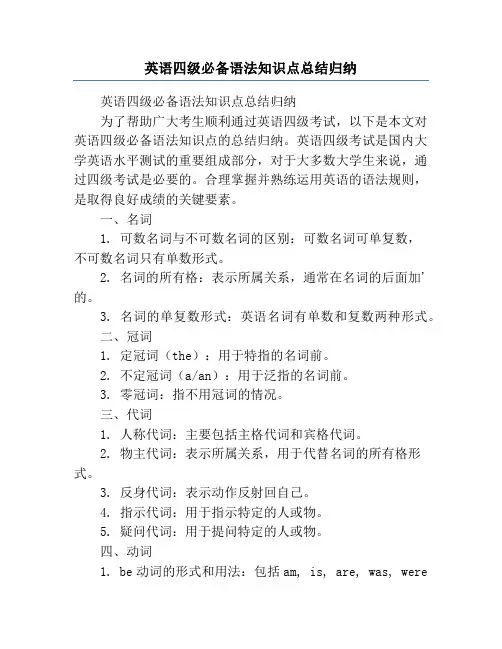
英语四级必备语法知识点总结归纳英语四级必备语法知识点总结归纳为了帮助广大考生顺利通过英语四级考试,以下是本文对英语四级必备语法知识点的总结归纳。
英语四级考试是国内大学英语水平测试的重要组成部分,对于大多数大学生来说,通过四级考试是必要的。
合理掌握并熟练运用英语的语法规则,是取得良好成绩的关键要素。
一、名词1. 可数名词与不可数名词的区别:可数名词可单复数,不可数名词只有单数形式。
2. 名词的所有格:表示所属关系,通常在名词的后面加'的。
3. 名词的单复数形式:英语名词有单数和复数两种形式。
二、冠词1. 定冠词(the):用于特指的名词前。
2. 不定冠词(a/an):用于泛指的名词前。
3. 零冠词:指不用冠词的情况。
三、代词1. 人称代词:主要包括主格代词和宾格代词。
2. 物主代词:表示所属关系,用于代替名词的所有格形式。
3. 反身代词:表示动作反射回自己。
4. 指示代词:用于指示特定的人或物。
5. 疑问代词:用于提问特定的人或物。
四、动词1. be动词的形式和用法:包括am, is, are, was, were等。
2. 一般现在时:表示经常性或普遍性的动作。
3. 一般过去时:表示过去发生的动作或状态。
4. 一般将来时:表示将来要发生的动作或状态。
5. 动词的时态:包括现在进行时、过去进行时、将来进行时等。
6. 动词的语态:包括主动语态和被动语态。
五、形容词和副词1. 形容词和副词的比较等级:用于表示不同程度的级别。
2. 形容词修饰名词:通常形容词位于名词的前面。
3. 副词修饰动词或形容词:通常副词位于动词或形容词的前面。
六、介词1. 表示位置关系:用于描述物体之间的位置关系。
2. 表示时间关系:用于描述事件或活动的发生时间。
3. 表示方式和手段:用于描述做事的方式或使用的手段。
4. 表示原因和目的:用于描述事件或行为的原因和目的。
七、连词1. 并列连词:用于连接同等重要的两个句子或成分。
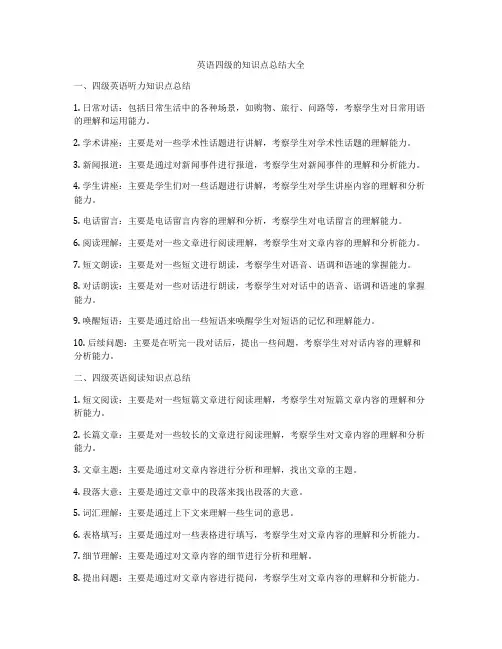
英语四级的知识点总结大全一、四级英语听力知识点总结1. 日常对话:包括日常生活中的各种场景,如购物、旅行、问路等,考察学生对日常用语的理解和运用能力。
2. 学术讲座:主要是对一些学术性话题进行讲解,考察学生对学术性话题的理解能力。
3. 新闻报道:主要是通过对新闻事件进行报道,考察学生对新闻事件的理解和分析能力。
4. 学生讲座:主要是学生们对一些话题进行讲解,考察学生对学生讲座内容的理解和分析能力。
5. 电话留言:主要是电话留言内容的理解和分析,考察学生对电话留言的理解能力。
6. 阅读理解:主要是对一些文章进行阅读理解,考察学生对文章内容的理解和分析能力。
7. 短文朗读:主要是对一些短文进行朗读,考察学生对语音、语调和语速的掌握能力。
8. 对话朗读:主要是对一些对话进行朗读,考察学生对对话中的语音、语调和语速的掌握能力。
9. 唤醒短语:主要是通过给出一些短语来唤醒学生对短语的记忆和理解能力。
10. 后续问题:主要是在听完一段对话后,提出一些问题,考察学生对对话内容的理解和分析能力。
二、四级英语阅读知识点总结1. 短文阅读:主要是对一些短篇文章进行阅读理解,考察学生对短篇文章内容的理解和分析能力。
2. 长篇文章:主要是对一些较长的文章进行阅读理解,考察学生对文章内容的理解和分析能力。
3. 文章主题:主要是通过对文章内容进行分析和理解,找出文章的主题。
4. 段落大意:主要是通过文章中的段落来找出段落的大意。
5. 词汇理解:主要是通过上下文来理解一些生词的意思。
6. 表格填写:主要是通过对一些表格进行填写,考察学生对文章内容的理解和分析能力。
7. 细节理解:主要是通过对文章内容的细节进行分析和理解。
8. 提出问题:主要是通过对文章内容进行提问,考察学生对文章内容的理解和分析能力。
9. 综合理解:主要是对一些较复杂的文章进行综合分析和理解。
三、四级英语写作知识点总结1. 日记写作:主要是对一些日常生活中的事情进行记录,考察学生对一些日常用语和语法的掌握能力。
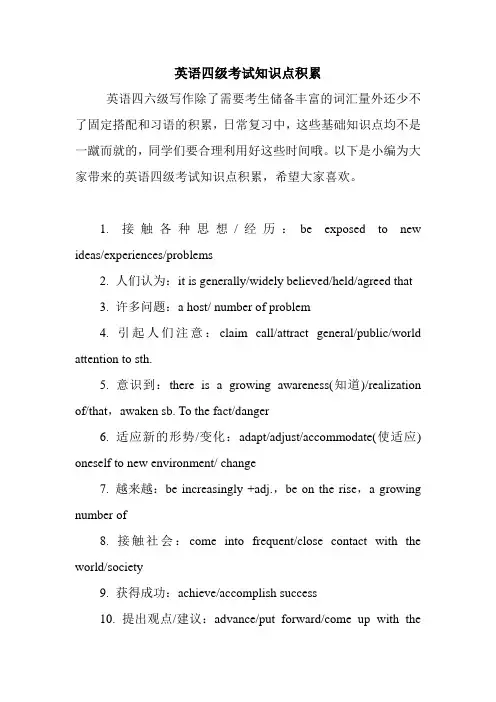
英语四级考试知识点积累英语四六级写作除了需要考生储备丰富的词汇量外还少不了固定搭配和习语的积累,日常复习中,这些基础知识点均不是一蹴而就的,同学们要合理利用好这些时间哦。
以下是小编为大家带来的英语四级考试知识点积累,希望大家喜欢。
1. 接触各种思想/经历:be exposed to new ideas/experiences/problems2. 人们认为:it is generally/widely believed/held/agreed that3. 许多问题:a host/ number of problem4. 引起人们注意:claim call/attract general/public/world attention to sth.5. 意识到:there is a growing awareness(知道)/realization of/that,awaken sb. To the fact/danger6. 适应新的形势/变化:adapt/adjust/accommodate(使适应) oneself to new environment/ change7. 越来越:be increasingly +adj.,be on the rise,a growing number of8. 接触社会:come into frequent/close contact with the world/society9. 获得成功:achieve/accomplish success10. 提出观点/建议:advance/put forward/come up with thearguments/ideas/suggestions11. 作出努力:make tremendous(极大的)/persistent(持久稳固的)/sustained(持续不变的) effort to do sth.,take great pains to do(with work/study)12. 影响学习:interfere with studies/work13. 产生影响:have/exert a profound(深刻的) influence on life/personality,have a dramatic/ undesirable(令人不快的) effect on14. 较好地驾驭生活:be a better pilot of one’s life15. 剥夺机会/权力:deprive oneself of the chance/right/opportunity16. 取代:substitute(替代) for/take the place of the old way17. 采取措施:take effective steps/measures to18. 控制我们的环境:take/gain increasing control over our own environment19. 躲避危险/挑战:shy(躲避)/run away from the dangers/challenge20. 满足要求:meet/satisfy/accommodate the demand of21. 补偿损失:compensate for / make up for the loss/damage22. 解释某现象:account for / explain the phenomenon23. 对……很好的了解:have a better understanding/appreciation of,have a new perspective(观点) on,provide/gain an insight into24. 把某因素考虑进去:take sth. into account(consideration),give much thought to25. 品位人生/自由青春:savor the life/freedom/youth26. 培养对……的信心:develop/foster one’s interest/confidence in27. 经历变化/困难/艰险:undergo/experience great changes/hardships/experience28. 表现出自信心等:project one’s confidence/feeling/image29. 生活充满不公正的地方:life is full of minor irritation/injustice30. 追求学习/职业:pursue one’s academic(理论的) interest/professional career31. 学习知识/技术:pursue/acquire knowledge/technology/skill32. 被看作学习的……榜样:be held up as a good example33. 交流经验/知识:share experience/ideas/problems/knowledge34. 发挥/起到重要作用:play an (important/active/great)role/part35. 逃学/缺课:skip school/a class/a meeting/a lecture36. 知识/经验丰富:rich in knowledge/experience37. 确立/追求目标:set/pursue a goal/higher standard38. 到达目标:achieve/accomplish/stain the goal/aim/object39. 克服困难:overcome obstacles/difficulty40. 面临危险/困难:be confronted/faced with/in the face of danger/difficulty41. 阻碍了成功:stand in the way of success,be an obstacle(障碍)/barrier to success/ growth42. 阻碍了发展:hamper/impede/stunt the development of43. 持传统的看法:hold conventional wisdom44. 发表看法:voice/express one’s opinion45. 持相反/合理的观点:take the opposite/fresh view46. 揭穿某种一贯的说法:shatter the myth of47. 求得帮助:enlist one’s support/help48. 建立在大量的学习/实践上:build on tremendous amount of study/practice49. 把成功/错误归咎于:attribute/own the success/failure to50. 对……重要:be indispensable/important/vital to51. 施加压力:put/exert a academic pressure on52. 重视:assign/attach much importance/significance to53. 强调:place/put much emphasis/stress/value on54. 把注意力集中在:focus/concentrate one’s attention/efforts/thoughts upon55. 提供机会/信息:provide/offer/furnish anopportunity/information for sb.56. 抓住机会:grab/seize/take the opportunity57. 得到机会:enjoy/gain access to a opportunity/likelihood that58. 有可能:there is (little/much)possibility/likelihood that,chances/the odds(可能的机会) are that59. 展开竞争:compete against/with sb. for the prize/position/control/the mastery of60. 开展运动:conduct(carryon/undertake/initiate/launch/wage)a vigorous/nation-wide/ publicity/advertising)61. 对我很有/没有什么意义:make much/little sense to me62. 带来无穷的幸福/满足:be a source of happiness satisfaction/contentment(满意)/pride/ complaint63. 献身于:devote/dedicate/commit oneself to a cause /career64. 大不(没什么)两样:make much(little/no)difference65. 真正重要的是:what really matters/accounts is……66. 改变生活旅程:change/alter the course of life67. 缩小差别:bridge/narrow/fell the gap/gulf(between city and country)68. 进行调查/执行任务:conduct/carry out an study/task/experiment69. 辞去工作/学习:leave/quit one’s job/work/school70. 参加考试/竞赛等:enter (for)the examination/contest, race。
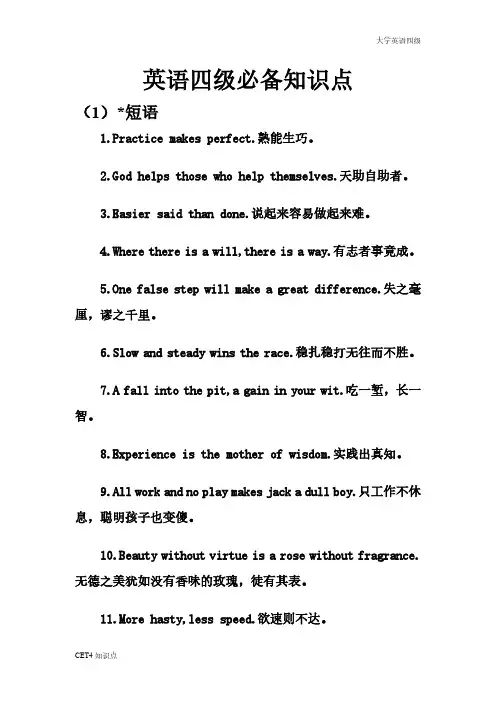
英语四级必备知识点(1)*短语1.Practice makes perfect.熟能生巧。
2.God helps those who help themselves.天助自助者。
3.Easier said than done.说起来容易做起来难。
4.Where there is a will,there is a way.有志者事竟成。
5.One false step will make a great difference.失之毫厘,谬之千里。
6.Slow and steady wins the race.稳扎稳打无往而不胜。
7.A fall into the pit,a gain in your wit.吃一堑,长一智。
8.Experience is the mother of wisdom.实践出真知。
9.All work and no play makes jack a dull boy.只工作不休息,聪明孩子也变傻。
10.Beauty without virtue is a rose without fragrance.无德之美犹如没有香味的玫瑰,徒有其表。
11.More hasty,less speed.欲速则不达。
12.It's never too old to learn.活到老,学到老。
13.All that glitters is not gold.闪光的未必都是金子。
14.A journey of a thousand miles begins with a single step.千里之行始于足下。
15.Look before you leap.三思而后行。
16.Rome was not built in a day.伟业非一日之功。
17.Great minds think alike.英雄所见略同。
18.well begun,half done.好的开始等于成功的一半。
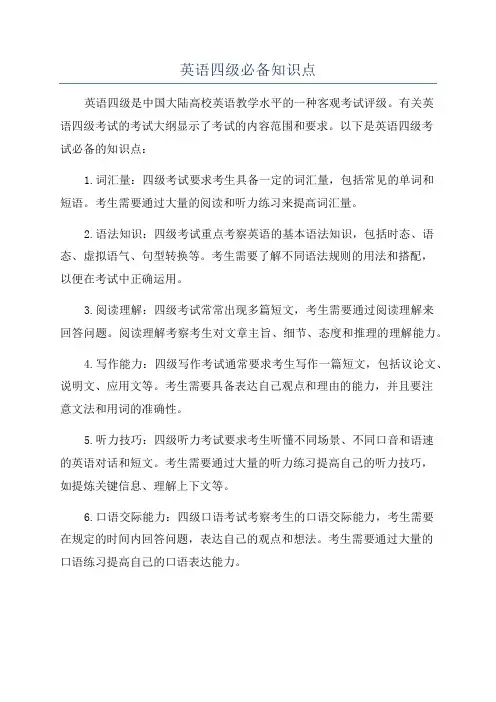
英语四级必备知识点英语四级是中国大陆高校英语教学水平的一种客观考试评级。
有关英语四级考试的考试大纲显示了考试的内容范围和要求。
以下是英语四级考试必备的知识点:1.词汇量:四级考试要求考生具备一定的词汇量,包括常见的单词和短语。
考生需要通过大量的阅读和听力练习来提高词汇量。
2.语法知识:四级考试重点考察英语的基本语法知识,包括时态、语态、虚拟语气、句型转换等。
考生需要了解不同语法规则的用法和搭配,以便在考试中正确运用。
3.阅读理解:四级考试常常出现多篇短文,考生需要通过阅读理解来回答问题。
阅读理解考察考生对文章主旨、细节、态度和推理的理解能力。
4.写作能力:四级写作考试通常要求考生写作一篇短文,包括议论文、说明文、应用文等。
考生需要具备表达自己观点和理由的能力,并且要注意文法和用词的准确性。
5.听力技巧:四级听力考试要求考生听懂不同场景、不同口音和语速的英语对话和短文。
考生需要通过大量的听力练习提高自己的听力技巧,如提炼关键信息、理解上下文等。
6.口语交际能力:四级口语考试考察考生的口语交际能力,考生需要在规定的时间内回答问题,表达自己的观点和想法。
考生需要通过大量的口语练习提高自己的口语表达能力。
7.多媒体辅助学习:四级考试中常常使用多媒体辅助学习,包括图片、音频和视频等。
考生需要熟悉多媒体工具的使用,如放音机、录音机、电脑等。
8.语境运用:四级考试对语言的运用进行了一定的限制,考生需要在规定的语境内运用语言,如公司、学校、饭店等。
考生需要了解不同语境下的表达方式和礼仪规范。
9.积极使用学习资源:四级考试的准备过程中,考生可以积极利用各种学习资源,如课本、教辅材料、网络资源等。
考生需要有自主学习的能力,不断扩充自己的知识和技能。
10.错误分析与纠正:四级考试的准备过程中,考生需要对自己的错误进行分析和纠正,以提高自己的英语水平。
考生可以参加模拟考试和语言学习班,通过自我评估和他人评估来找出自己的问题所在。
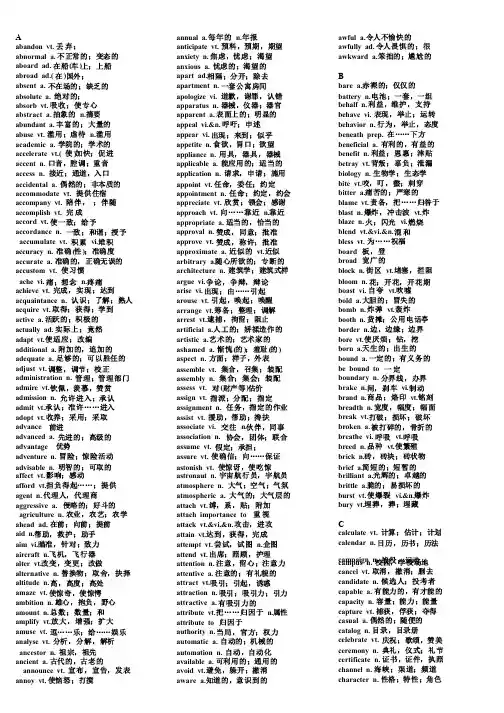
A abandon vt.丢弃;abnormal a.不正常的;变态的aboard ad.在船(车)上;上船abroad ad.(在)国外;absent a.不在场的;缺乏的absolute a.绝对的;absorb vt.吸收;使专心abstract a.抽象的n.摘要abundant a.丰富的;大量的abuse vt.滥用;虐待n.滥用academic a.学院的;学术的accelerate vt.(使)加快;促进accent n.口音,腔调;重音access n.接近;通道,入口accidental a.偶然的;非本质的accommodate vt.提供住宿accompany vt.陪伴,;伴随accomplish vt.完成accord vt.使一致;给予accordance n.一致;和谐;授予accumulate vt.积累vi.堆积accuracy n.准确(性);准确度accurate a.准确的,正确无误的accustom vt.使习惯ache vi.痛;想念n.疼痛achieve vt.完成,实现;达到acquaintance n.认识;了解;熟人acquire vt.取得;获得;学到active a.活跃的;积极的actually ad.实际上;竟然adapt vt.使适应;改编additional a.附加的,追加的adequate a.足够的;可以胜任的adjust vt.调整,调节;校正administration n.管理;管理部门admire vt.钦佩,羡慕,赞赏admission n.允许进入;承认admit vt.承认;准许……进入adopt vt.收养;采用;采取advance 前进advanced a.先进的;高级的advantage 优势adventure n.冒险;惊险活动advisable n.明智的;可取的affect vt.影响;感动afford vt.担负得起……;提供agent n.代理人,代理商aggressive a.侵略的;好斗的agriculture n.农业,农艺;农学ahead ad.在前;向前;提前aid n.帮助,救护;助手aim vi.瞄准,针对;致力aircraft n.飞机,飞行器alter vt.改变,变更;改做alternative n.替换物;取舍,抉择altitude n.高,高度;高处amaze vt.使惊奇,使惊愕ambition n.雄心,抱负,野心amount n.总数;数量;和amplify vt.放大,增强;扩大amuse vt.逗……乐;给……娱乐analyse vt.分析,分解,解析ancestor n.祖宗,祖先ancient a.古代的,古老的announce vt.宣布,宣告,发表annoy vt.使恼怒;打搅annual a.每年的n.年报anticipate vt.预料,预期,期望anxiety n.焦虑,忧虑;渴望anxious a.忧虑的;渴望的apart ad.相隔;分开;除去apartment n.一套公寓房间apologize vi.道歉,谢罪,认错apparatus n.器械,仪器;器官apparent a.表面上的;明显的appeal vi.&n.呼吁;申述appear vi.出现;来到;似乎appetite n.食欲,胃口;欲望appliance n.用具,器具,器械applicable a.能应用的;适当的application n.请求,申请;施用appoint vt.任命,委任;约定appointment n.任命;约定,约会appreciate vt.欣赏;领会;感谢approach vt.向……靠近n.靠近appropriate a.适当的,恰当的approval n.赞成,同意;批准approve vt.赞成,称许;批准approximate a.近似的vt.近似arbitrary a.随心所欲的;专断的architecture n.建筑学;建筑式样argue vi.争论,争辩,辩论arise vi.出现;由……引起arouse vt.引起,唤起;唤醒arrange vt.筹备;整理;调解arrest vt.逮捕,拘留;阻止artificial a.人工的;娇揉造作的artistic a.艺术的;艺术家的ashamed a.惭愧(的);羞耻(的) aspect n.方面;样子,外表assemble vt.集合,召集;装配assembly n.集合;集会;装配assess vt.对(财产等)估价assign vt.指派;分配;指定assignment n.任务,指定的作业assist vt.援助,帮助;搀扶associate vi.交往n.伙伴,同事association n.协会,团体;联合assume vt.假定;承担;assure vt.使确信;向……保证astonish vt.使惊讶,使吃惊astronaut n.宇宙航行员,宇航员atmosphere n.大气;空气;气氛atmospheric a.大气的;大气层的attach vt.缚,系,贴;附加attach importance to 重视attack vt.&vi.&n.攻击,进攻attain vt.达到,获得,完成attempt vt.尝试,试图n.企图attend vt.出席;照顾,护理attention n.注意,留心;注意力attentive a.注意的;有礼貌的attract vt.吸引;引起,诱惑attraction n.吸引;吸引力;引力attractive a.有吸引力的attribute vt.把……归因于n.属性attribute to 归因于authority n.当局,官方;权力automatic a.自动的;机械的automation n.自动,自动化available a.可利用的;通用的avoid vt.避免,躲开;撤消aware a.知道的,意识到的awful a.令人不愉快的awfully ad.令人畏惧的;很awkward a.笨拙的;尴尬的B bare a.赤裸的;仅仅的battery n.电池;一套,一组behalf n.利益,维护,支持behave vi.表现,举止;运转behavior n.行为,举止,态度beneath prep.在……下方beneficial a.有利的,有益的benefit n.利益;恩惠;津贴betray vt.背叛;辜负;泄漏biology n.生物学;生态学bite vt.咬,叮,螫;剌穿bitter a.痛苦的;严寒的blame vt.责备,把……归咎于blast n.爆炸,冲击波vt.炸blaze n.火;闪光vi.燃烧blend vt.&vi.&n.混和bless vt.为……祝福board 板,登broad 宽广的block n.街区vt.堵塞,拦阻bloom n.花;开花,开花期boast vi.自夸vt.吹嘘bold a.大胆的;冒失的bomb n.炸弹vt.轰炸booth n.货摊;公用电话亭border n.边,边缘;边界bore vt.使厌烦;钻,挖born a.天生的;出生的bound a.一定的;有义务的be bound to 一定boundary n.分界线,办界brake n.闸,刹车vi.制动brand n.商品;烙印vt.铭刻breadth n.宽度,幅度;幅面break vt.打破;损坏;破坏broken a.被打碎的,骨折的breathe vi.呼吸vt.呼吸breed n.品种vt.使繁殖brick n.砖,砖块;砖状物brief a.简短的;短暂的brilliant a.光辉的;卓越的brittle a.脆的;易损坏的burst vt.使爆裂vi.&n.爆炸bury vt.埋葬,葬;埋藏C calculate vt.计算;估计;计划calendar n.日历,历书;历法campaign n.战役;运动campus n.校园,学校场地cancel vt.取消,撤消;删去candidate n.候选人;投考者capable a.有能力的,有才能的capacity n.容量;能力;能量capture vt.捕获,俘获;夺得casual a.偶然的;随便的catalog n.目录,目录册celebrate vt.庆祝;歌颂,赞美ceremony n.典礼,仪式;礼节certificate n.证书,证件,执照channel n.海峡;渠道;频道character n.性格;特性;角色characteristic a.特有的n.特性charge vt.索价;控告n.费用charity n.施舍;慈善事业charming a.迷人的,可爱的chief a.主要的;首席的chill vt.使变冷n.寒冷choice n.选择,抉择choose vt.选择,挑选;情愿circuit n.电路;环行;巡行circular a.圆的;循环的circulate vt.使循环vi.循环circumstance n.情况,条件;境遇civil a.公民的;文职的civilization n.文明,文化;开化civilize vt.使文明;教育claim vt.声称,主张;索取clarify vt.澄清,阐明classical a.古典的;经典的classification n.分类;分级;分类法classify vt.把……分类cliff n.悬崖,峭壁clue n.线索,暗示,提示clumsy a.笨拙的;愚笨的coarse a.粗的,粗糙的code n.规则;collapse vi.倒坍;崩溃,瓦解collect vt.收集vi.收款collection n.搜集,收集;收藏品collective a.集体的;集合性的collision n.碰撞;冲突colony n.殖民地;侨居地column n.柱,专栏combination n.结合,联合;化合combine vt.使结合;兼有combine …withcommand vt.命令,指挥;控制comment n.评论评论,意见;注释commerce n.商业,贸易;社交commercial a.商业的;商品化的commission n.委任状;委员会commit vt.犯(错误);干(坏事)commit a crimecommon a.普通的;共同的communicate vi.通讯;传达;传播communication n.通讯;传达;交通community n.社区;社会;公社companion n.同伴;共事者;伴侣comparative a.比较的,相对的compare vt.比较,对照;比作compare…with compare…to comparison n.比较,对照;比似compel vt.强迫,迫使屈服compete vi.比赛;竞争;对抗competition n.竞争,比赛competent a.有能力的;应该做的complain vi.抱怨,拆苦;控告complaint n.抱怨;怨言;控告complete a.完整的;完成的complex a.结合的;复杂的complicated a.复杂的,难懂的component n.组成部分;组件compose vt.组成,构成;创作be composed of 由。
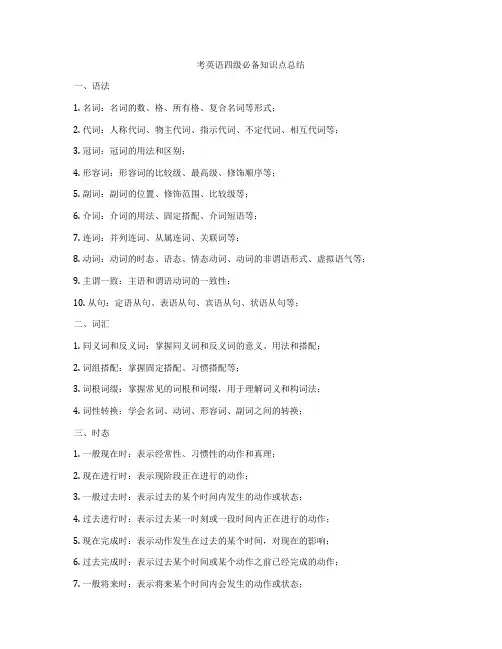
考英语四级必备知识点总结一、语法1. 名词:名词的数、格、所有格、复合名词等形式;2. 代词:人称代词、物主代词、指示代词、不定代词、相互代词等;3. 冠词:冠词的用法和区别;4. 形容词:形容词的比较级、最高级、修饰顺序等;5. 副词:副词的位置、修饰范围、比较级等;6. 介词:介词的用法、固定搭配、介词短语等;7. 连词:并列连词、从属连词、关联词等;8. 动词:动词的时态、语态、情态动词、动词的非谓语形式、虚拟语气等;9. 主谓一致:主语和谓语动词的一致性;10. 从句:定语从句、表语从句、宾语从句、状语从句等;二、词汇1. 同义词和反义词:掌握同义词和反义词的意义、用法和搭配;2. 词组搭配:掌握固定搭配、习惯搭配等;3. 词根词缀:掌握常见的词根和词缀,用于理解词义和构词法;4. 词性转换:学会名词、动词、形容词、副词之间的转换;三、时态1. 一般现在时:表示经常性、习惯性的动作和真理;2. 现在进行时:表示现阶段正在进行的动作;3. 一般过去时:表示过去的某个时间内发生的动作或状态;4. 过去进行时:表示过去某一时刻或一段时间内正在进行的动作;5. 现在完成时:表示动作发生在过去的某个时间,对现在的影响;6. 过去完成时:表示过去某个时间或某个动作之前已经完成的动作;7. 一般将来时:表示将来某个时间内会发生的动作或状态;8. 现在将来时:表示过去某一时刻之后会发生的动作;四、语态1. 主动语态:动作的执行者位于主语的位置;2. 被动语态:动作的承受者位于主语的位置;五、形容词和副词的比较级和最高级1. 比较级:两者之间的程度比较;2. 最高级:三者或三者以上的程度比较;六、虚拟语气1. 虚拟条件句:表示与现实相反的假设;2. 虚拟语气:表示与现实相反的愿望、建议、命令等;七、固定搭配和习惯表达1. 不定式的固定搭配;2. 动词短语的固定搭配;3. 习惯的表达方式;八、阅读1. 文章大意把握:对文章的主旨、中心思想有清晰的了解;2. 名词、冠词和代词的指代:注意文章中名词的指代和代词的指代;3. 语篇结构:掌握文章的段落结构和句子结构;4.常见题型:主旨大意题、细节题、推断题、态度观点题等;九、写作1. 作文基本结构:包括引言、正文、结论;2. 句子结构:掌握句子的简单、复合、并列等结构;3. 衔接词和过渡句:上下文之间的衔接;4. 写作技巧:逻辑、严密的论述,正反两方面的看待问题等;以上就是英语四级必备知识点的总结,通过对以上知识点的掌握和练习可以有效地提高英语能力。
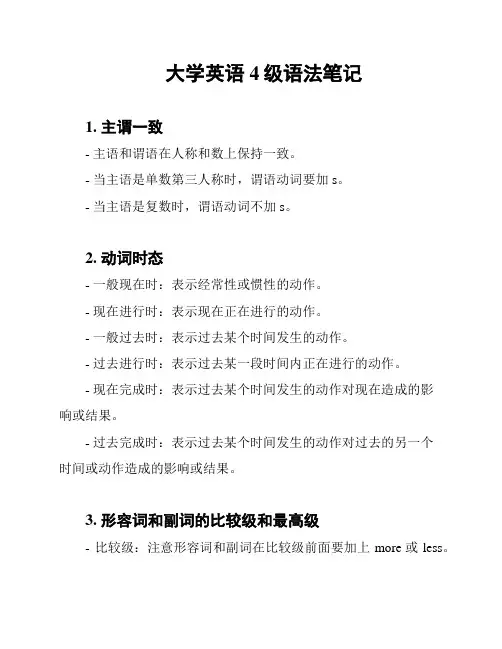
大学英语4级语法笔记
1. 主谓一致
- 主语和谓语在人称和数上保持一致。
- 当主语是单数第三人称时,谓语动词要加s。
- 当主语是复数时,谓语动词不加s。
2. 动词时态
- 一般现在时:表示经常性或惯性的动作。
- 现在进行时:表示现在正在进行的动作。
- 一般过去时:表示过去某个时间发生的动作。
- 过去进行时:表示过去某一段时间内正在进行的动作。
- 现在完成时:表示过去某个时间发生的动作对现在造成的影
响或结果。
- 过去完成时:表示过去某个时间发生的动作对过去的另一个
时间或动作造成的影响或结果。
3. 形容词和副词的比较级和最高级
- 比较级:注意形容词和副词在比较级前面要加上more或less。
- 最高级:注意形容词和副词在最高级前面要加上the most或the least。
4. 名词所有格
- 表示属于关系时,在名词后面加's。
- 表示复数名词所有格时,在名词后面加'。
5. 祈使句和感叹句
- 祈使句表示命令、请求或建议,一般用动词原形。
- 感叹句表示惊讶、赞叹等情感,常以What、How等引导。
6. 介词的用法
- 介词用于表示位置、时间、方式等关系。
- 常用的介词有in、on、at、under、over等。
以上是大学英语4级语法的一些基础知识点,请在学习和写作时注意运用。
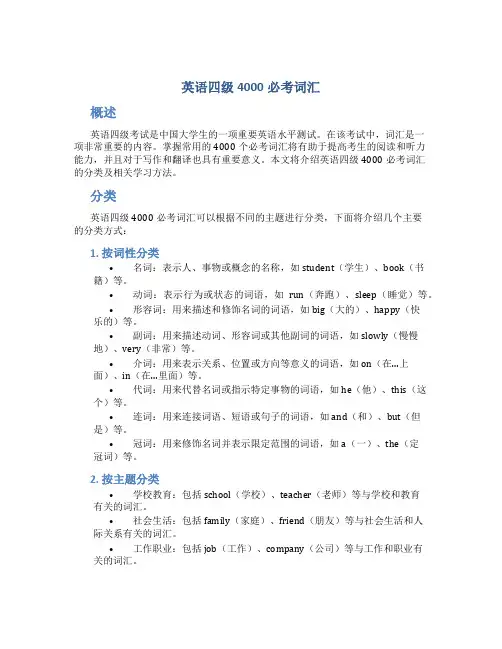
英语四级4000必考词汇概述英语四级考试是中国大学生的一项重要英语水平测试。
在该考试中,词汇是一项非常重要的内容。
掌握常用的4000个必考词汇将有助于提高考生的阅读和听力能力,并且对于写作和翻译也具有重要意义。
本文将介绍英语四级4000必考词汇的分类及相关学习方法。
分类英语四级4000必考词汇可以根据不同的主题进行分类,下面将介绍几个主要的分类方式:1. 按词性分类•名词:表示人、事物或概念的名称,如student(学生)、book(书籍)等。
•动词:表示行为或状态的词语,如run(奔跑)、sleep(睡觉)等。
•形容词:用来描述和修饰名词的词语,如big(大的)、happy(快乐的)等。
•副词:用来描述动词、形容词或其他副词的词语,如slowly(慢慢地)、very(非常)等。
•介词:用来表示关系、位置或方向等意义的词语,如on(在…上面)、in(在…里面)等。
•代词:用来代替名词或指示特定事物的词语,如he(他)、this(这个)等。
•连词:用来连接词语、短语或句子的词语,如and(和)、but(但是)等。
•冠词:用来修饰名词并表示限定范围的词语,如a(一)、the(定冠词)等。
2. 按主题分类•学校教育:包括school(学校)、teacher(老师)等与学校和教育有关的词汇。
•社会生活:包括family(家庭)、friend(朋友)等与社会生活和人际关系有关的词汇。
•工作职业:包括job(工作)、company(公司)等与工作和职业有关的词汇。
•健康生活:包括health(健康)、exercise(锻炼)等与健康和生活方式有关的词汇。
•环境保护:包括environment(环境)、pollution(污染)等与环境保护有关的词汇。
•文化艺术:包括art(艺术)、music(音乐)等与文化艺术相关的词汇。
学习方法掌握英语四级4000必考词汇需要一定的学习方法和技巧,下面将介绍几种常用的学习方法:1. 单词卡片法将每个单词写在一张卡片上,一边写单词,一边写单词的词性和中文意思。
大学英语四级必考语法汇总大学英语四级考试是学生们普遍参加的考试,语法是其中必考的部分,以下是四级必考语法汇总:1. 时态英语时态有12种,四级考试中要掌握以下几种:- 一般现在时:表示经常性或惯性的动作,或现在的状况。
- 现在进行时:表示现在正在进行的动作。
- 一般过去时:表示过去某个时间发生的动作或情况。
- 过去进行时:表示过去某个时间正在进行的动作。
- 现在完成时:表示过去的动作对现在造成的影响或结果。
- 过去完成时:表示过去某个时间之前曾经发生的动作或状态。
- 将来时:表示将来某个时间发生的动作。
2. 从句从句是指一个完整的句子,它在句子中充当某个成分,四级考试中要掌握以下几种:- 定语从句:修饰某个名词或代词。
- 主语从句:作为主语的从句。
- 宾语从句:作为宾语的从句。
- 同位语从句:阐述前面名词或代词的内容。
- 状语从句:修饰或补充主句的内容。
- 结果状语从句:表示结果的从句。
- 让步状语从句:表示让步的从句。
- 条件状语从句:表示条件的从句。
3. 词性和词组四级考试中需要掌握名词、代词、动词、形容词和副词的用法,以及一些固定用法的词组,例如:- be based on:基于。
- be fond of:喜欢。
- as soon as possible:尽快。
- break the ice:打破僵局。
4. 语态英语语态有两种,四级考试中需要了解和区分主动语态和被动语态,以及两种语态在句子中的变化。
5. 语气英语语气有三种,四级考试中需要了解和区分陈述语气、祈使语气和虚拟语气。
以上就是大学英语四级必考语法的汇总,希望对大家备考有所帮助。
2023上半年英语四级必备语法知识点(1)非谓语动词与独立主格:短语,句子(或者句子,短语)当短语部分有独立主语,并且该主语不同于句子主语,这时短语结构称为独立主格。
(它最明显的特点是短语部分有独立的主语)。
独立主格的结构1:名词(代词)+ 分词[现在分词、过去分词]现在分词表示主动的,正在进行的行为;过去分词表示被动的,已经完成的行为。
作题时要通过判断动作与名词(代词)之间的关系来确定是使用现在分词还是过去分词。
当动作由名词(代词)发出时使用现在分词,而名词(代词)是受动者时则用过去分词。
1. Silver is the best conductor of electricity,copper _B_ it closely.A followedB followingC to followD being followed2. All things _A_,the planned trip will have to be called off.A consideredB be consideredC consideringD having consideredcall off 取消; cancel vt. 取消; 四级中的考点就是现在分词和过去分词的区别。
独立主格的结构2:with + 名词(代词)+ 分词[句子当中作状语]3. After the Arab states won independence,great emphasis was laid on expanding education,with girls as well as boys _C_ to go to school.A to be encouragedB been encouragedC being encouragedD be encouragedas well as 和(相当于and); be encouraged不会考。
英语四级知识点一、核心/高频词汇核心词汇不用说,真正的词汇高频考点是哪些呢?总结历年英语四级真题,你会发现,高频词汇并非是生词难词,最常考察的往往是考察一词多义,近义词辨析,同义替换,词性活用,熟词僻义等等。
这些往往是词汇书学不到的,需要研读真题,在真题中掌握。
很多真题已经把这些作为重点解析了,比如巨微——四级真题/逐句精解,在逐句注释真题文章中的词汇时,特别注释了这些常考的词汇考点,大家应该对这些部分重点研究。
二、基本的语法知识英语四级不同于考研英语,不会考查过分复杂的长难句,但是为了更好的理解文章,写出更有水平的英语作文,还是需要对基础的语法知识有一定的掌握。
首先,简单句的主谓宾/主系表结构要分清,尤其是谓语动词部分,这是句子的灵魂所在,要学会分解这些成分。
平时在读文章时,要有意识的分解句子结构,总结其语法特点。
三、写作模板/范文和好词好句写作模板/范文是需要大量的背诵的,建议每周背3篇范文,选择不同类型的记忆。
英语四级写作主要考察图画作文和议论文,要多多积累相关的范文和句式,比如描述图画内容的,分列论点论据的……平时也要注意积累好词好句,比如一些名人名言,谚语,一些好的句式等等。
将这些句子摘抄在笔记本中,常常拿出来记忆,用到写作中也能为自己的文章增色不少。
四、解题思路和解题技巧前辈的经验也有一定的借鉴意义,可以多去请教考过四六级的学姐学长。
也可以多去逛逛英语四级的论坛和贴吧,看看别人的复习心得,也能积累一些珍贵的复习资料。
但总而言之,更多的解题思路和解题技巧是需要自己大量做题去总结的,将真题认真的研究,做过的真题要反复做,反复回看。
认真对照答案,分析答案解析,确保将所有的知识点都融会贯通。
复习的时候要将错题重点标记下来,最好能将考点整理下来,避免下次再做错。
只要你总结的够多,你会发现这些解题技巧都是类似的套路,很容易掌握。
也可以选择看一些视频课,推荐“零元课”网站,里面的视频虽然是免费的,但是确实很好,讲的解题技巧很实用。
英语四级必考知识点总结英语四级必考知识1语法部分考查重点1、虚拟语气的考点为:would rather+that从句+一般过去时;It is vital/ necessary/ important/ urgent/imperative/ desirable/ advisable/ natural/essential+that+(should)动词原形;proposal/suggestion+that+动词原形;It is time/about time/high time+that+一般过去时;lest+that+should+动词原形;if only+that+would+动词原形。
2、状语从句的考点为:非if引导的条件状语从句,此类句子多用at times,provided,so long as,in case,once等来替代if;由even if/so,now that,for all等引导的让步状语从句;just/hardly...when引导的时间状语从句;more than,as...as,not so much as,the same as,as much as等引导的比较状语从句。
3、独立主格结构多以逻辑主语+分词的形式出现。
4、情态动词多与完成时形式连用。
5、定语从句重点考查介词+关系代词(which)和as作为关系代词。
英语四级必考知识2词汇部分考查重点1、动词、名词与介词的搭配如:popular/patient+with;yield/solution/adapt/transfer/access+to;accuse/require+of;charge+for;under+discussion等等。
2、习惯用法如:confess to/set about/be used to+doing;be supposed to/have/make sb.+do等。
3、由同一动词构成的短语如:e,go,set,break等构成的短语。
大学英语四级知识点大学英语四级知识点一、考试概述大学英语四级考试是一项面向全国大学生的英语水平测试,主要考察学生的英语听、读、写、译能力。
考试内容包括听力理解、阅读理解、翻译和写作四个部分,满分为710分。
考试每年举行两次,分别在6月和12月的第三个周六。
二、听力理解听力理解部分主要考察学生听取和理解英语口语的能力,包括短篇新闻、长对话和短文理解三个部分。
备考时,建议多听英语广播、新闻,熟悉不同口音的英语,并练习抓住关键信息。
三、阅读理解阅读理解部分包含三个题型:选词填空、段落匹配和阅读理解。
选词填空要求学生在文章中选择合适的单词填空,段落匹配则要求学生找出与题目匹配的段落,阅读理解考察学生对文章的理解和解题能力。
备考时,建议多读各类英语文章,提高阅读速度和理解能力。
四、翻译翻译部分考察学生将英文翻译成中文的能力。
备考时,建议积累词汇和语法知识,多练习翻译,培养语言转换能力。
五、写作写作部分要求学生根据给定的主题或情境写一篇文章。
备考时,建议多写多练,积累常用表达和句型,同时注意语法和拼写错误。
六、备考建议备考大学英语四级考试,建议制定合理的复习计划,充分利用历年真题进行模拟练习。
要保持良好的心态和信心,克服对考试的恐惧,注重基础知识的积累和语言能力的提升。
总之,大学英语四级考试是一项重要的英语水平测试,备考过程中要注重基础知识的掌握和实践能力的提升。
希望以上知识点能够帮助大家更好地备考,取得优异的成绩。
大学英语四级知识点汇总大学英语四级知识点汇总一、主题本文将汇总和解析大学英语四级考试的各类知识点,包括完形填空、阅读理解、写作等部分,以帮助考生全面了解四级考试的难点和策略。
二、完形填空完形填空是大学英语四级考试的重要部分,它要求考生在理解文章大意的基础上,选择合适的单词或短语来填充文本,使文章语法正确、意义完整。
1、词汇量:扩大词汇量是成功完成完形填空的关键。
考生需要熟练掌握常见单词和短语,了解近义词之间的区别,以便在考试时快速、准确地选择答案。
大学英语四级必背单词词汇表在大学英语四级考试中,掌握一定量的必背单词是取得好成绩的关键之一。
以下是为大家整理的一份较为全面的大学英语四级必背单词词汇表,希望能对大家的备考有所帮助。
一、基础词汇1、 abandon əˈbændən v 遗弃;放弃2、 ability əˈbɪləti n 能力;才能3、able ˈeɪbl adj 能够的;有能力的4、abnormal æbˈnɔːml adj 反常的;不正常的5、 aboard əˈbɔːd prep 在(船、飞机、车)上6、 abolish əˈbɒlɪʃ v 废除;取消7、 abortion əˈbɔːʃn n 流产;堕胎8、 about əˈbaʊt prep 关于;大约9、 above əˈbʌv prep 在……上面;高于10、 abroad əˈbrɔːd adv 在国外;到国外二、动词词汇1、 absorb əbˈsɔːb v 吸收;吸引2、 abuse əˈbjuːz v 滥用;虐待3、 accelerate əkˈseləreɪt v 加速;促进4、access ˈækses n 通道;入口 v 接近;获取5、 accommodate əˈkɒmədeɪt v 容纳;提供住宿6、 accompany əˈkʌmpəni v 陪伴;伴随7、 accomplish əˈkʌmplɪʃ v 完成;实现8、 account əˈkaʊnt n 账户;解释 v 认为;说明9、 accumulate əˈkjuːmjəleɪt v 积累;积聚10、 accuse əˈkjuːz v 控告;指责三、形容词词汇1、accurate ˈækjərət adj 准确的;精确的2、 accustomed əˈkʌstəmd adj 习惯的;惯常的3、adequate ˈædɪkwət adj 足够的;适当的4、 adjacent əˈdʒeɪsnt adj 邻近的;毗连的5、 adjustable əˈdʒʌstəbl adj 可调节的;可调整的6、admirable ˈædmərəbl adj 令人钦佩的;值得赞赏的7、adolescent ˌædəˈlesnt adj 青春期的;青少年的8、 advanced ədˈvɑːnst adj 先进的;高级的9、advantageous ˌædvənˈteɪdʒəs adj 有利的;有益的10、 adventurous ədˈventʃərəs adj 爱冒险的;大胆的四、名词词汇1、 achievement əˈtʃiːvmənt n 成就;成绩2、 acquaintance əˈkweɪntəns n 熟人;相识3、acquisition ˌækwɪˈzɪʃn n 获得;收购4、activity ækˈtɪvəti n 活动;行动5、adaptation ˌædæpˈteɪʃn n 适应;改编6、 addition əˈdɪʃn n 增加;加法7、 address əˈdres n 地址;演讲 v 写地址;演讲8、 administration ədˌmɪnɪˈstreɪʃn n 管理;行政9、 admission ədˈmɪʃn n 准许进入;承认10、adolescence ˌædəˈlesns n 青春期五、副词词汇1、absolutely ˈæbsəluːtli adv 绝对地;完全地2、accidentally ˌæksɪˈdentəli adv 偶然地;意外地3、 accordingly əˈkɔːdɪŋli adv 相应地;照着4、accurately ˈækjərətli adv 准确地;精确地5、actually ˈæktʃuəli adv 实际上;事实上6、 approximately əˈprɒksɪmətli adv 大约;近似地7、 apparently əˈpærəntli adv 显然地;似乎8、automatically ˌɔːtəˈmætɪkli adv 自动地;无意识地9、basically ˈbeɪsɪkli adv 基本上;主要地10、certainly ˈsɜːtnli adv 当然;必定以上只是大学英语四级必背单词词汇表的一部分,大家在备考过程中,还需要结合历年真题、模拟题以及相关的英语学习资料,不断扩充自己的词汇量。